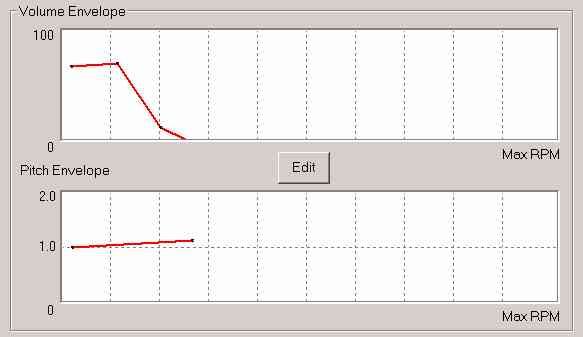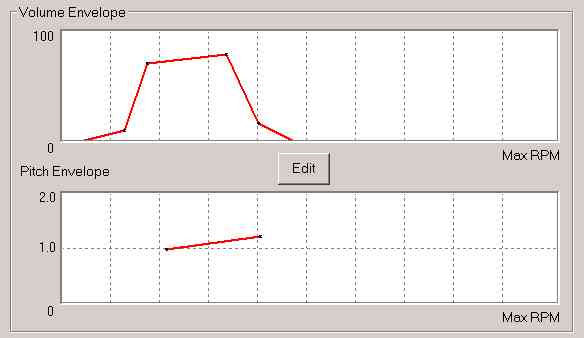Sound.cfg file Examples
| · | A Simple Example - STALL_WARNING
|
A simple example is the stall warning sound. During flight, if the aircraft stalls, the .wav file associated with this event is played for as long as the aircraft is stalled. The config file stall warning event is STALL_WARNING. The viewpoint is set so the sound is heard only inside the cockpit. The C172 stall sound definition looks like this in the sound.cfg file:
[STALL_WARNING]
filename=c172_stallhorn
viewpoint=1
|
|
| · | A more complex Example - WIND_SOUND
|
The wave file used to represent wind would not sound right if it were to be played at a constant volume and pitch -- the wind noise in the C172 should not sound the same at 50 knots as it does at 120 knots. Also, as the airspeed increases, the pitch of the sound should also increase. This is accomplished by specifying minimum and maximum speeds, volumes and rates for the sound. This is how it looks for the default C172:
[WIND_SOUND]
filename=wind3
viewpoint=1
minimum_speed=40.00
maximum_speed=120.00
minimum_volume=6000
maximum_volume=8500
minimum_rate=0.60
maximum_rate=0.90
In this case, at airspeeds at or below 40 knots, the sound is played at a volume of 6000 ( 0 is minimum, 10000 is maximum), and a rate or pitch of 0.60 of the raw file. At airspeeds at or above 120 knots, the sound is played at a volume of 8500, and a rate of 0.90. Between these two airspeeds, the volume and rate are interpolated, and will fall somewhere between the two extremes.
| · | Complex Sound Example - the C172 SOUND_ENGINE
|
Engine sounds are very complex, and vary dramatically as the RPM and airspeed varies. FS breaks down the total sound into multiple components to allow many wav files to mix together -- this more accurately conveys the sound. The C172 (and all single engine prop planes) can specify up to 6 predefined sound types or events in the SOUND_ENGINE section of the sound.cfg file. The SOUND_ENGINE section of the C172 looks like this:
[SOUND_ENGINE]
number_of_engines=1
ENG1_COMBUSTION_START=combstart
ENG1_STARTER=starter
ENG1_SHUTDOWN=shutdown
ENG1_COMBUSTION=COMBUSTION.1.00
ENG1_PROP=PROP.1.00
ENG1_NON_COMBUSTION=NON_COMBUSTION.1.00
|
|
Finally we have the most complex section of a sound.cfg file -- three Sounds which play all the time the engine is running. Sounds representing the prop, for combustion noises, and for non-combustion, "mechanical" noises. If you're creating your own sound configuration, you may not be able to supply accurate sounds for each, but a satisfactory effect can be had by mixing a sound list of about 4 files for just combustion. Take a look at existing aircraft to see how other designers are dealing with this.
To further our example, let's take a look at the C172 ENG1_COMBUSTION sounds. They're defined by a Sound List named COMBUSTION.1.00. If we take a look at this entry in the sound.cfg file, we see the following:
[COMBUSTION.1.00]
filename=c172_rpm1
flags=0
viewpoint=1
rparams=0.023000,0.989000,0.264000,1.110000
vparams=0.021000,65.599998,0.113000,68.000000,0.199000,11.200000,0.255000,0.000000,0.530000,0.000000,0.530000,0.000000,0.530000,0.000000,0.530000,0.000000
link=COMBUSTION.1.01
Note the viewpoint (internal to the cockpit) and filename for the wave file. We also have both a Volume and Rate envelope defined. If we were to plot these out, we'd see the following:

As the RPM of the engine increases the Volume of this wave file is played at about a constant value. At about 11% of the maximum engine RPM, the sound decreases in volume until at about 25% of maximum RPM, it's inaudible. The rate or pitch of the sound increases slightly as the RPM increases.
If this were the only entry in the Sound List, you'd only hear the engine as it was idling, as the throttle was increased, the sound would fade out. However, note the link value. This tells FS that this sound list has another entry, COMBUSTION.1.01. Looking at this entry in the sound.cfg, we see the following:
[COMBUSTION.1.01]
filename=c172_rpm2
flags=0
viewpoint=1
rparams=0.211000,0.977000,0.400000,1.203000
vparams=0.039000,0.000000,0.127000,9.600000,0.174000,69.599998,0.333000,77.599998,0.396000,16.000000,0.468000,0.000000,0.731000,0.000000,0.863000,0.000000
link=COMBUSTION.1.02
And graphing out the rate and volume envelopes we see the following:


Here we see how the four entries in the ENG1_COMBUSTION sound list combine to create the internal Combustion sound for the C172.